Abstract
In this paper, the authors describe the principles ofStraight Line Strokes illustration, present the mathematical model of the principles, and show how a great number of lines can be implemented as main part of an automated drawing system namedLine-Art. Different from traditional drawing art, Line-Art generates pictures without curves, colors, ink marks, brushes, and oil paint, but only with Straight Line Strokes. Generated pictures are composed, clipped, and plotted. The paper also introduces how to use the initial value problem of the ordinary differential equation to describe a drawing art, e.g. Line-Art.
Similar content being viewed by others
References
Dehlinger H, Mathias G. Computer an der Kunthochschule. Ghk, 1985.
Dehlinger H, Versuch 12 zu Konturen. Plottergraphie in: Computerkunst in Deutschland, Barke-verlag, Muenchen, ISBN 3-926167-01-7, 1987.
Dehlinger H. Cube 4. Ausstellungsbeitrag zur “SIGGRAPH ART SHOW 1989” in LeonardoJ. of the International Society for the Art, Sciences and Technology, Supplemental Issue 1989, Pergamon Press, New York, 1989.
Dehlinger H. Cube 4. In:Second International Symposium of Electronic Art, Groningen, Holland, Rikshogeschool, 1990.
Dehlinger H. Line-Art: An Algorithm Experiment and Explorations into Pictorial Space Cmposed of Lines. Research Report, Univ. of Kassel, Germany, 1993.
Jiang Jin, Jiang Huihui. Design Art. Hunan Art Press, 1991.(in Chinese)
Li Zhi. The History of the Line-Drawing in the Eastern and Western Painting, and the Comparison. Hunan Art Press, 1989. (in Chinese)
Qi Dongxu. Fractal and Its Application. Scientific Press, Beijing, 1994. (in Chinese)
Xu Yingqing, Huang Xinyuang. D-curve and its fractal structure. In:Proc. the 3rd Chinese Symposium on Fractal and its application, Hefei, China, 1993, pp.80–83.
Author information
Authors and Affiliations
Additional information
This project is supported by the National Natural Science foundation of China.
Xu Yingqing received his B.S. degree from Mathematics Department of Jilin University in 1982, and his Ph.D. degree from Institute of Computing Technology, Chinese Academy of Sciences in 1997. Presently, he is a staff of Industrial Management & Design Engineering Research Center, Institute of Software, CAS. His research interests include computer art, computer graphics, animation, image processing and physically based modeling.
Hans Dehlinger (E-mail: dehl@cad.uni-kassel.de, http://www.uni-kassel.de/fb24) is a Professor in Department of Product-Design at the University of Kassel, Germany. In 1969 he entered the Graduate Program of the College of Environmental Design at the University of California, Berkeley, where he received his Ph.D. degree and begun to work extensively with computers in planning and design. He is a head of the Institute “Design-Kunst-Computer” at the University of Kassel. His interest in computer assisted art is centered around algorithmically generated drawings produced on pen-plotters and he has made numerous contributions to computer art exhibitions in Germany and abroad among them to the Siggraph Travelling Art Show on 1989. In 1996 he got awarded the “Golden Plotter” by the City of Gladbeck in Germany.
Qi Dongxu graduated from Mathematics Department of Jilin University in 1963. Presently, he is a Professor, and Director of the CAD Center of North China University of Technology. His research interests include computer graphics, animation, computational mathematics, computer art and wavelet analysis, etc.
Liu Shenquan graduated from Mathematics Department of Sichuan University in 1956, and received his Ph.D. degree in Russia in 1962. Presently, he is a Professor of Institute of Computing Technology, Chinese Academy of Sciences. His research interests include computer graphics, visualization, animation, CAD/CAM, etc.
Rights and permissions
About this article
Cite this article
Xu, Y., Hans, D., Qi, D. et al. Line-art and its mathematical models. J. of Comput. Sci. & Technol. 13, 73–78 (1998). https://doi.org/10.1007/BF02946616
Received:
Revised:
Issue Date:
DOI: https://doi.org/10.1007/BF02946616




